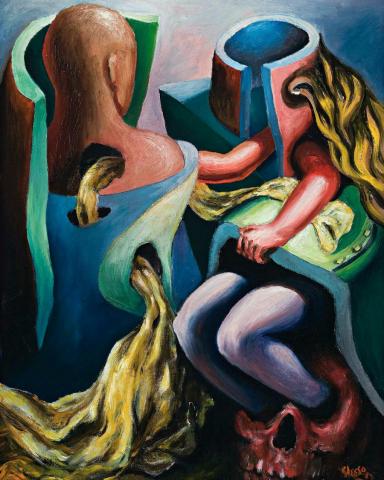THE BETROTHAL OF TWO CLASSIC EDIFICES, 1943
James Gleeson
oil on canvas on board
50.0 x 40.0 cm
signed lower right: Gleeson
inscribed verso: “THE BETROTHAL OF TWO CLASSIC EDIFICES”
Tony Palmer, Sydney
Private collection, Western Australia
The Betrothal of Two Classic Edifices belongs to a significant group of paintings James Gleeson produced in 1943, in which human figures emerge from or are locked into a variety of structural forms. These structures morph the man-made and the geology of the earth: rocks being a favourite Gleeson motif, speaking of primal things before the appearance of order and reason.
Early evidence of Gleeson's imaginative exploration is found in Structural Emblems of a Friend, 1941, in the collection of the Queensland Art Gallery, in which parts of the face of the artist have been peeled back to reveal an underlying structure of carved stones or bricks. Eau + Feu = Calamité, 1943, (whereabouts unknown) embraces contrary elements, and imprisons human figures within its constructions. The definitive statement is provided in the triptych, The Five Wounds, 1943. The commanding centre panel, The Five Wounds, is in the collection of the National Gallery of Australia, Canberra. Of the left and right panels - The Personal Contortion and The Edge of Knowledge - one is in the Agapitos/Wilson collection and the other destroyed. The juxtaposition of the male and female figure is constant in all these paintings. In The Betrothal of Two Classic Edifices they are quite anonymous, showing the male back view of shaved head and the female golden locks like a colourful fabric. The bite is at the other end, as her mauve stockings of the most delightful hue end in the empty eye sockets of a red skull.
The several meanings of the word 'edifice' encompass the inspiring, grand building and the complex conceptual structure. Gleeson leans towards the latter without casting aside the former, for the glory of creation is mankind. To rise above the purely rational allows the irrational and creative subconscious to come into play. While Gleeson's images called up from the id probe and provoke, he dresses them in the most palatable and seductive of hues.
DAVID THOMAS
